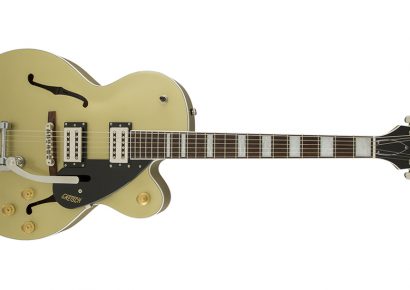I put the JD-LS3 up against my Les Paul Traditional. Both guitars are designed in the tradition of 1950’s Les Paul Standards but J&D also offer the JD-LC3, which is in the style of a Les Paul Custom. The J&D has a solid mahogany body, though no mention in the specs of a maple top. It has a maple set neck, as opposed to the mahogany of the originals, but all other specs appear to be in order: 22 fret rosewood fingerboard with crown inlays, tune-o-matic style bridge and stopbar tailpiece, two volume controls, two tone controls, three-way pickup selector switch and a pair of humbucking pickups. The hardware is chrome, and the machine heads are die cast. This guitar feels considerably lighter than my Traditional, in fact, most of the weight seems to be coming from the neck rather than the body. This seems to lend credence to the ‘there’s no maple top’ theory implied by the spec sheet.
As for construction quality, in this price range you can’t expect quite the same level as a hand-selected-from-over-a-dozen-Traditionals $3000+ Gibson USA, but it’s quite impressive for the cost. There are a few little giveaways that this isn’t a top-shelf instrument though: for instance, on the review guitar one of the 12th fret side dots is badly misaligned, and the finish over the binding on the treble side has a few odd, shimmery spots where the poly seems to have lifted or possibly taken a few fingerprints between sprays. It’s not a huge deal, but you’ll notice it if you’re looking for flaws.
The humbucking pickups on this guitar are hotter, more modern-voiced units compared to vintage-style ‘buckers which are typically much lower in output. That means you’ll get more of a crunchy, chunky, rock-and-metal-approved tone rather than the almost single coil-like singing quality of a true PAF-style pickup. But I get the feeling these hotter pickups are exactly what a lot of players expect when they think of the Les Paul tone: certainly Gibson itself hasn’t been shy about upping the output on their post-50’s buckers. The neck pickup sounds satisfyingly juicy with good sustain and harmonics, and the bridge pickup does everything from percussive chunk to screaming leads easily. They’re not the most characterful pickups ever, but they get the job done very nicely.
Slight finishing issues aside and there’s no indication that there’s anything iffy going on from a structural point of view and ignoring for a moment a few variations in materials, this guitar quite accurately captures many of the traits of a real Les Paul. It doesn’t have the weight, which for many players is a good thing, but it has the visual vibe and much of the classic tone. If you’re after a Les on a budget, check it out.

